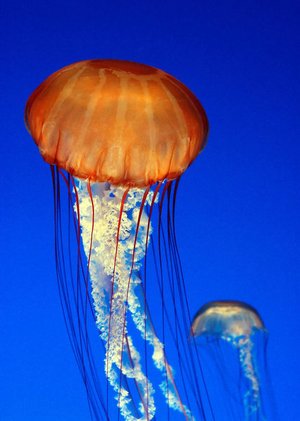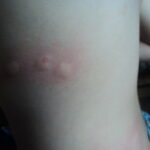Every summer beachgoers around the globe must deal with a variety of hazards. While most of them can be traced to human factors, a few occur naturally. As I found out one summer, there are hidden unseen dangers floating in the water. One second you are laughing and playing in the water and the next, you are screaming in agony as your legs suddenly feel like they are on fire. You’ve just been stung by a jellyfish. What should you do?
Avoiding jellyfish altogether is the best way to prevent stings. While jellyfish swarms can be predicted to phases of the moon in some parts of the world, not all jellyfish are predictable or detectable. (2) Jellyfish can float on the water while others drift underwater. The deadly Irukandji ‘box jellyfish’ is barely detectable to the naked eye. Additionally, jellyfish tentacles can be over 100 feet in length or they can detach and still sting for several weeks. (3)
The world’s oceans are filled with over 200 species of jellyfish of which 70 are known to envenomate (sting). (2) The toxicity or the severity of the sting depends upon the jellyfish and its venom. The three classes of jellyfish that commonly affect beachgoers are the members of the Hydrozoan, Scyphozoan (true jellyfish), and Cubozoan classes of the Cnidaria phylum. (3)
Stings by true jellyfish tend to be the least toxic and painful. From personal experience, stings by Hydrozoans (Portuguese man-of-war) are very painful and can cause tissue scarring for several years. Mild stings by Cubozoans such as the box jellyfish can be deadly within 60 seconds (3). How one treats jellyfish stings depends upon the attacking species, where the sting occurs, and the immune response of the victim (3).
To understand how to treat stings, it helps to understand the jellyfish stinging mechanism. The actual jellyfish stinging cells are nematocysts which are stored telescope-like with the ‘outside facing inward’ within the larger cnidoblast. Once activated by physical contact, jellyfish nematocysts’ drill telescope-wise into their victims and release their venom. Microscopic barbs at the end of the nematocyst keep it attached to the victim.
Once stung, the first impulse is to immediately start wiping the tentacles away and rub the effected area. This may only trigger unfired nematocysts attached to the skin and inject more venom. According to a recent eMedicine article “The venom of many species is complex and largely unknown. The majority of toxins contain a complex mixture of polypeptides and proteins including (1) catecholamines, (2) histamine, (3) hyaluronidase, (4) fibrinolysins, (5) kinins, (6) phospholipases, and (7) various hemolytic, cardiotoxic, and dermatonecrotic toxins.” (3) Increased envenomations may lead to an increased reaction to the additional toxin.
Stings can produce one of three types of responses to the injected toxin – an immediate allergic reaction, a delayed allergic reaction, or a toxic reaction (3). Most beachgoers in North America will experience a mild to painful sting from the toxins contained in commonly encountered jellyfish. In a few individuals, their immune system will react to the venom and lapse into anaphylactic shock. Thus, treatment for jellyfish stings should be done on an individual basis according to the reaction.
First responders to a jellyfish sting victim should first protect themselves and the victim from further injury by inactivating the remaining nematocysts. This can be accomplished by using a 4-6% solution of acetic acid (household vinegar) for a minimum of 30 seconds. Soaking for 30 minutes is recommended. Alternative solutions can be Coca-cola, old wine, or hot water. Do not use – rubbing alcohol, liquor, urine, or fresh water (3).
Once the nematocysts have been inactivated with vinegar, the attached tentacles can be removed (3). It is best to remove the tentacles with tweezers as live nematocysts can sting through surgical gloves. They can also be scraped away with dive fins, a towel, or a credit card. Check for signs of anaphylaxis – difficulty breathing and swallowing, swelling, or severe pain. Seek immediate medical attention.
Stings occurring in the mouth area, eyes, genital require special care. Vinegar can be dabbed around the eyes with a towel to loosen and inactivate the tentacles and nematocysts. Mouth stings can be treated with a ¼ strength vinegar solution used as a mouthwash. Spit out the wash after use. You should seek medical help if in doubt.
Stings by the box jellyfish species inhabiting the waters around Hawaii generally result in a very painful sting. (2) The box jellyfish stings by species in Australasia are serious and can result in death. Antivenom injection may be required. Seek immediate medical attention. (3)
Pain management will be a top priority with jellyfish sting victims. Toxins can kill localized skin cells and can release systemic toxins. Victims will want relief from both. Using a cold compress over the sting area will help in many cases. A hot pack may help with severe pain. According to eMedicine “Topical anesthetics and corticosteroids may also relieve pain”. (3) Jellyfish Squish is one commercial product with lidocaine that appears to produce quick relief. Systemic body pains that are caused by the toxins can be treated with acetaminophen and Ibuprofen. Consult the label for proper dosage. (7) Anti-histamines may also prove useful.
Wounds caused by stings should be monitored for several weeks to check for infection or delayed allergic reaction. Localized skin damage and scarring may occur. (personal experience)
Recent studies have shown that jellyfish swarms are increasing worldwide. This may be due to increased ocean water temperatures or jellyfish filling a void left by over-fished species. (5) It does mean the chances of your being stung on your next trip to the beach are increasing. Be prepared and the next life you save may be your own.
More on Associated Content:
Nurses Who Steal Narcotics and Pain Medication
Bacteria Hazards of Swimming in Freshwater Lakes and Ponds
What Tests Detect Vitamin D Deficiency
Sources:
1. Stoppler, Melissa. “Jellyfish Sting FAQs: What You Should Know Before Entering the Water!” 16 May 2006 http://www.medicinenet.com/script/main/art.asp?articlekey=62024
2. Hawaiian Lifeguard Association. “Jellyfish.” June 30, 2005. (Sept. 26, 2008) http://www.aloha.com/~lifeguards/jelyfish.html
3. Daubert, G. Patrick. “Cnidaria Envenomation.” 18 August 2008. http://emedicine.medscape.com/article/769538-overview
4. Horton, Jennifer. “Do jellyfish have the deadliest venom in the world?” 06 October 2008. HowStuffWorks.com. 27 July 2009. Jellyfish Nematocysts: A Sting Operation
5. National Science Foundation. “Jellyfish Gone Wild” http://www.nsf.gov/news/special_reports/jellyfish/index.jsp
6. Milton S. Hershey Medical Center “Jellyfish Stings” 17 February 2009 http://www2.hmc.psu.edu/healthinfo/hie/1/002845.htm
7. “Jellyfish Stings Treatment” http://firstaid.webmd.com/jellyfish-stings-treatment






